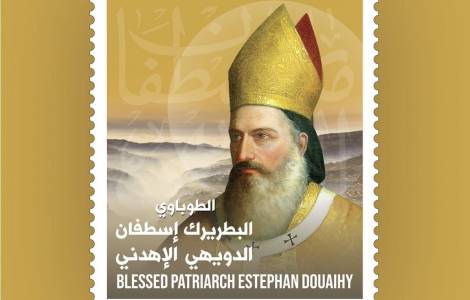
Beirut (Agenzia Fides) - "The righteous will flourish like the palm tree, will grow like the cedar of Lebanon". This is how Cardinal Marcello Semeraro began his homily during the solemn liturgical celebration of the beatification of Stephen Douayhy (1630-1704), Patriarch of Antioch of the Maronites, which he presided over yesterday evening, Friday, August 2, in the presence of the current Maronite Patriarch, Cardinal Bechara Boutros Rai. Before a crowd of more than 10,000 people gathered at the patriarchal seat of Bkerké, including hundreds of priests, men and women religious from all the Maronite dioceses of the world, the Prefect of the Dicastery for the Causes of Saints, in outlining the figure of the new Blessed, also expressed the desire that "Lebanon continue to be a place where men and women can live in harmony and peace with one another".
"The new blessed Stephen", recalled Cardinal Semeraro, "was Patriarch of the Maronite Church for more than thirty years, "in difficult times of external persecution and internal dissensions". During these long years, "it can be said that he did not know a single day of peace".
However, "there was no bitterness in his heart. On the contrary, he said to those who had mistreated and persecuted him: "I forgive you for what you have done to me. I am ready to suffer more for the love of the Lord who suffered and died for me."
The grateful memory of Stephen Douayhy has been cherished for centuries by the children of the Maronite Church. His story is intertwined with the tribulations experienced by Maronite Christians and bears exemplary witness to the bond of communion that unites the Maronite Church and the Church of Rome.
Born on August 2, 1630 in Ehden (northern Lebanon) into a noble family, after also studying Arabic and Syriac at the age of 11, he was sent to the Maronite Seminary in Rome, where he obtained a doctorate in philosophy and continued his research for manuscripts dealing with Maronite history and liturgy.
Returning to his homeland, he was ordained a priest on March 25, 1656. He carried out his apostolate in several parishes in Lebanon and Syria, especially in Aleppo, devoting himself to helping the poor and contributing to the dialogue between the Eastern Churches and the Catholic Church. At that time, he was appointed a missionary of Propaganda Fide.
After a visit to the Holy Land, he was ordained bishop in 1668 and sent to the Maronites of the island of Cyprus.
On May 20, 1670, he was elected Patriarch of the Maronites, when he was only forty years old. As Patriarch, he also supported the revival of the great Maronite religious orders, by returning their monastic rules, which had been aligned with the regulations in force in the Latin world, to the teachings of Saint Anthony Abbot, the forerunner of monasticism.
Due to persecution and harassment by the rulers, he was often forced to take refuge in mountain monasteries or in the caves of Wadi Qannoubine. He died in Qannoubin on May 3, 1704 and was buried in the cave of Saint Marina.
Blessed Stephen also carried out an intense intellectual activity, publishing important writings on the Maronite liturgy and history, the mysteries of the Catholic faith, sermons and other philosophical and theological works.
After the Process of Canonization began, the decree on the heroic exercise of virtues by Patriarch Stephen was promulgated on July 3, 2008. The miraculous healing that paved the way for his beatification was that of Rosetta Karam, a mother of three children, who suffered from seronegative rheumatic polyarthritis that had left her disabled and demoralized, to the point of prompting her to stop all treatment. Her "instantaneous, complete and lasting" healing came after a family prayer before the statue of the Patriarch that stands in front of the church of Ehden, the birthplace of the new Blessed.
"The main protagonist of the invocation", reports the documentation released by the Dicastery for the Causes of Saints, "was the neighbor who, together with some members of the Fraternity of the Immaculate Conception, led the sick woman to the statue of the Venerable Servant of God that was near their house and began to pray to him. According to a local rite, the friend invited the sick woman to drink a coffee in which had been mixed earth collected at the feet of the statue of the Venerable Servant of God, which she did with great faith". After drinking the coffee, Rosetta "felt a strong burning sensation, got up and began to walk alone towards the statue to thank the Patriarch. Shortly after, she walked about a kilometer to reach her sister's house and personally announce the news of her healing". (GV/PR) (Agenzia Fides, 3/8/2024)